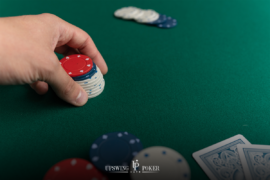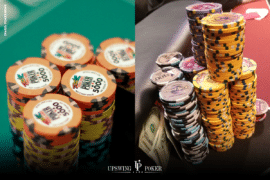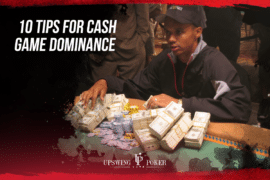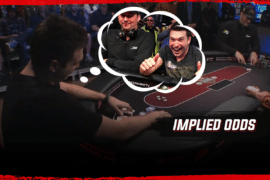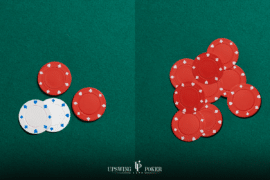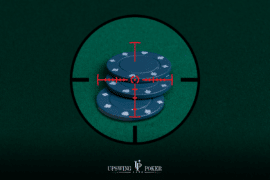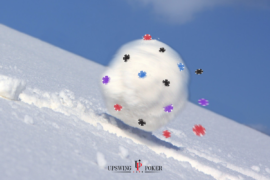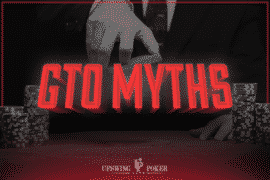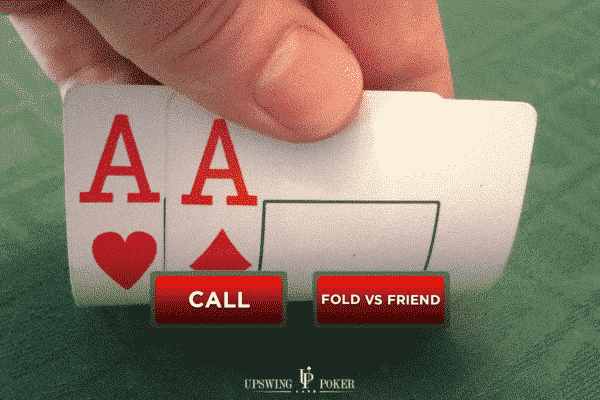
Should He Fold Pocket Aces to a Close Friend? (Analysis)
When two friends clash at the poker table, it generally goes one of three ways:
- Some friends go after each other relentlessly;
- Others (consciously or unconsciously) try to avoid each other;
- And some just play their game and let the cards fall where they may.
I ended up in this situation when I squared off vs my podcast co-host and friend Dara O’Kearney at the MPN Prague in 2019.
We study together, talk a lot of poker, and share rooms during poker trips, so there were some interesting and complicated dynamics in effect during the following hand.
Watch the video below or keep reading to see what happened:
Editor’s Note: This article is by Irish tournament pro and Unibet Poker ambassador David Lappin who is a great follow on Twitter. Alongside Irish poker legend Dara O’Kearney, David produces and hosts the GPI global poker award winning podcast ‘The Chip Race” sponsored by Unibet Poker. All episodes are available on Apple Music, SoundCloud and Stitcher.
Background
Game: MPN Prague €550 Main Event
Format: No Limit Hold’em
Blinds: 200/300
Ante: 300 BB ante
Stage: Level 4
Relevant Stacks:
UTG+1 (O’Kearney): 127bb
UTG+2 (Lappin): 137bb
Preflop
UTG opens to 2.3bb. Dara calls with A♦️ A♥️ from UTG+1. I call with 5♦️ 4♦️ from UTG+2. The Button calls. The Big Blind also calls.
Preflop Analysis
The first noteworthy thing is Dara choosing to just-call his Pocket Aces. Obviously, the standard play here is to 3-bet Aces — and that’s what should be done most of the time — but Dara believes that calling has merit too.
His reasoning is that he is going up against a very tight UTG range, so there aren’t many hands that he can 3-bet for value. Because of this, it makes it difficult for him to find enough bluffs to balance his range while also having board coverage. It also has the added benefit of strengthening his calling range.
Now, on to my decision…
My call with 5♦️ 4♦️ is on the loose side. My logic in calling was that I perceived both the player UTG and Dara as having strong ranges, and a suited connector is the type of hand that can crack those ranges and win a big pot.
The loose call by me here is also somewhat protected by the fact that UTG’s raise and Dara’s call will be perceived as strong by the other players. This makes being squeezed less likely and additional callers more likely — a turn of events I would not hate with my hand that plays well multiway.
Note: Want to know how to play every hand in every common preflop situation? Get instant access to extensive preflop charts and lessons (for cash games, heads-up and tournaments) when you join the Upswing Lab training course. Lock your seat now!
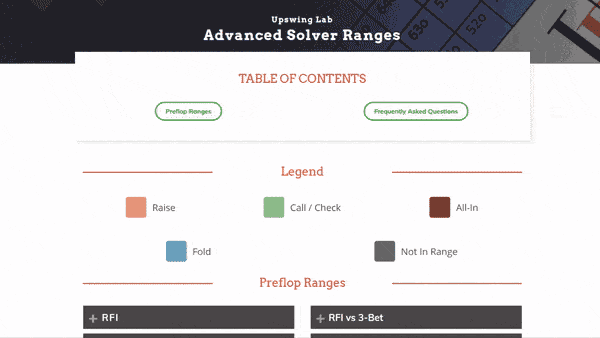
The Advanced Solver Ranges for cash games — one of five sets of preflop charts in the Upswing Lab.
Flop
The Pot: 13.2bb
The Flop: 7♠️ 4 ♣️ 4♠️
The Action: Big Blind checks. UTG checks. Dara checks. I bet 6.7bb. Button calls. Big Blind folds. UTG folds. Dara calls.
Flop Analysis
After the preflop raiser checks, Dara elects to check with his Aces. Both checking and betting small are fine options here, given that several players could hold a 4.
This is obviously a very favorable flop for my hand, but it is still wise to proceed with a bit of caution since there are 5 players in the pot. Trips is a very strong hand, obviously, but I have pretty much the worst trips possible. That said, my hand is still strong enough to value bet.
Now, back to Dara.
Once I bet and the Button calls, Dara must proceed very cautiously. He beats 7x, overpairs and flush draws, but it is very possible that there is a 4x hand or 77 lurking.
Versus the range of possible hands, Aces are way too strong to fold right now, but not strong enough to raise. His aces are under-repped, and it’s possible that he is in amazing shape versus two lower pocket pairs.
Turn
The Pot: 33.2bb
The Turn: (7 ♠️ 4 ♣️ 4♠️) 4♥️
The Action: Dara checks. I bet 21.7bb. Button folds. Dara calls.
Turn Analysis
This is a particularly favorable turn card for me, which instantly dispels any worries I had that I was behind. In fact, the only hands that have any equity against me are 77 and a sprinkling of straight-flush possibilities.
My priority at this point is to figure out the best way to extract chips from the likely ranges of my two villains, one of whom is a good friend.
Assessing both ranges, Dara clearly has the stronger of the two. He can have all the pocket pairs AA-88 (though JJ-KK is quite unlikely). The Button could have a medium pocket pair, some 7x combos, or a draw. He also has the problem of Dara behind him, so he can probably only call with the very top of his range.
I think it’s quite likely I will only get one more street of value here, so I choose a relatively big 2/3rd pot sizing. I expect to get called by all of the stronger hands in both players’ ranges.
Dara’s call is standard. I can perhaps have made this bet with a hand like JJ, looking to keep control of the pot and deny equity versus overcard hands. If I got called, I’d almost certainly check back on the river.
River
The Pot: 76.5bb
The River: (7♠️ 4 ♣️ 4♠️ 4♥️) 7♣️
Stack-to-Pot Ratio: 1.25:1
The Action: Dara leads for 26.7bb. I shove for 69.6bb more. Dara folds.
River Analysis
The 7♣️ means I no longer have the nuts, but to think too long about a single combination is to believe in monsters under the bed. My plan is to proceed as if I still have the winner.
Surprisingly, Dara leads for 30%, which is a very clever bet upon reflection. If I had a hand like JJ or TT, I would have been planning to check back on the river, hoping to win at showdown.
Dara’s bet nullifies that plan and targets those middling pocket pairs. It also serves as a block bet — he can be confident that if I raise now, his hand is likely not be good.
When I shove, I am thinking that I only get called by Aces sometimes (6 combos) and perhaps a 7x hand (which is quite unlikely given Dara’s line). That’s not too many hands, but since I was only behind one combo, I went for it.
Results
Dara makes a good fold and I pull in a pot of 209bb. Dara leaves himself with 69.6bb, still more than enough to battle back to average stack.
Wrapping Up
Individually, loose-passive players are weak and easily exploitable. Collectively, they are a nightmare! This multiway pot started off as one of those landmine spots, but quickly developed into a clash of two players who knew each other’s games intimately.
In the end, I think both of us played our hands pretty well.
What do you think of Dara’s plays with Aces? What about my plays with 54s?
Let me know in the comments below.
If you want more tournament hand analysis, check out Doug Polk Semi-Bluffs All-In With $3.7 Million at Stake (Analysis).
Thanks for reading.
Note: Ready to join 6,000+ players currently upgrading their No Limit Hold’em skills? Crush your competition with the expert strategies you will learn inside the Upswing Lab training course. Learn more now!
